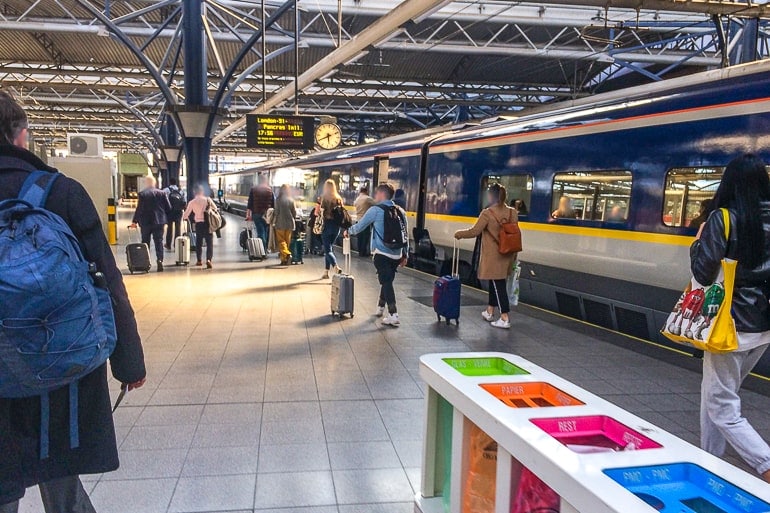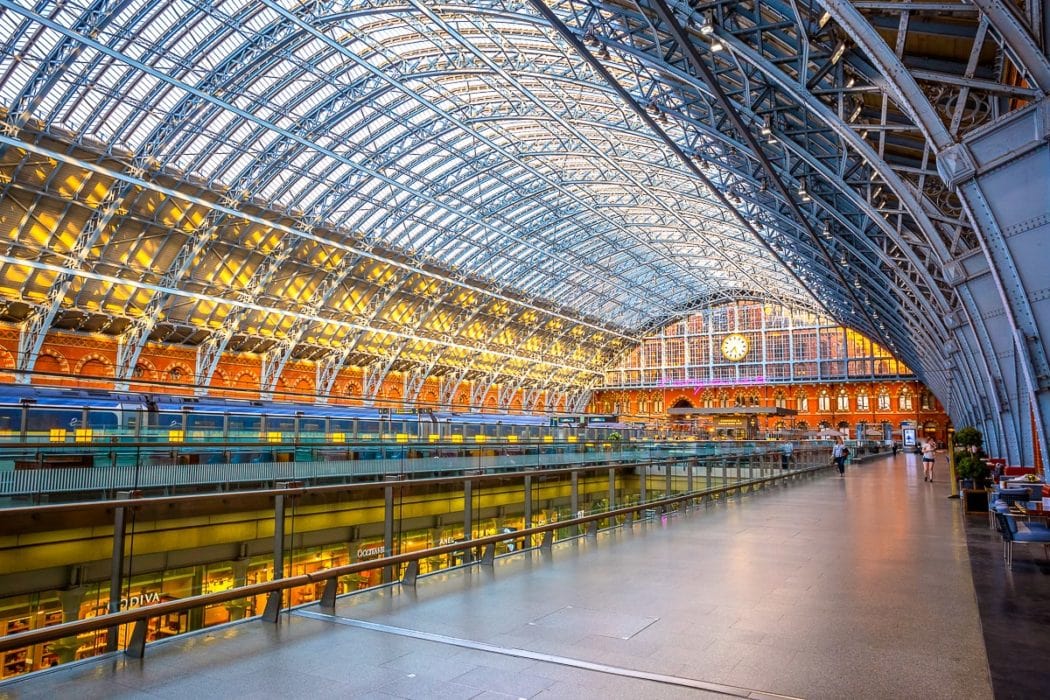Taking the Train between Continental Europe and London is Easy!
Travelling between London and continental Europe and don’t want to fly? Take the train! Taking a train through the Channel Tunnel from London to Paris, Brussels or Amsterdam (or the other way) is a great way to travel easily travel between cities and to see more on the way!
We really like train travel, in general, and opt to take the train all over Europe. There are lots of great Europe train passes that can help you go further for less. Eric recently travelled to London via the Eurostar train and it was a great experience from start to finish.
So, whether you are looking for those European cities which make it easy to travel to London by train or you are just curious what it’s like to take a train through the Channel Tunnel, here’s our experience taking the train between mainland Europe and London!
If you are travelling around Europe and/or heading for London, check out these helpful posts on the topic:
Table of Contents
What is the “Channel Tunnel”?
In case you didn’t know, you can take the train from mainland Europe to London – and, of course, from London to mainland Europe. The train passes under the English Channel through a tunnel called the “Channel Tunnel” or “Chunnel”. This tunnel was completed in 1994 and is the only fixed link between continental Europe and the island of Great Britain.
There are a number of ways to actually get on a train to go through the tunnel. The two common ways for travellers are driving your car ONTO the train and going through the tunnel or getting on a train yourself and riding through the tunnel.
We’ve never put a car on train before but know people who have and it was a fairly smooth experience. It’s operated by Eurotunnel and is great for road trips between the two places if you have your own car. You can book this ticket through the Eurotunnel website.
The other way is to be a passenger on the Eurostar which is a high-speed passenger train. This train runs from London at St. Pancras International Station (right beside King’s Cross) and links up a number of centres in continental Europe like Paris, Lille, Brussels, and more recently, Amsterdam.
You can book tickets on the Eurostar website. They also have a handy app for managing your reservations, displaying your tickets, and more.
Taking The Eurostar Train to London
Now that we’ve talked a little bit about what the Eurostar is, it’s important to share our experience so that if you’re unfamiliar with the whole system, you might think about trying it out someday. This is going to be Eric’s experience of taking the Eurostar from Brussels to London.
Technically, he took the train from Brussels Zuid/Midi Station to Ashford International Station (the stop in Kent before central London) BUT he’s been through St. Pancras Station multiple times and knows what the Eurostar experience looks on at that end. In any case, the experience on the train is the same regardless of which station you start and end at.
If you are starting in continental Europe, you will likely be starting in Paris at Gare du Nord, Brussels Midi/Zuid, Lille Europe, or Amsterdam Centraal (newly added in 2020).
Generally speaking, the experience at any of these stations to get on the Eurostar is pretty similar: scan your ticket to get through the gates, go through security and passport control, and then wait in a departures lounge until everyone is called to board. You also need to be around an hour early to get checked-in. That’s it!
Check-in/Boarding the Eurostar
In Brussels, the Eurostar departures area is under platforms 1 and 2. It’s very well signed so you will not miss it. Once there, you scan your ticket at the gates to enter the departures area when they accept passengers for your train departure time. There are usually multiple trains so they have a good system in place.
Once inside, it works like a less-stressed airport. Eric went through a metal detector while his bag went through the x-ray machine. At the time of writing, there are differences compared to flying. For example, you do not have a restriction on the amount of liquid you can bring on the train. Also, shoes and belts stayed on so it was just a simple emptying of the pockets.
After security, Eric passed through passport control. This differs depending on the station set-up but will include the same two steps – leaving Europe and entering the UK. Brussels included a live person to “leave” the Schengen Zone (but he basically just waved Eric through seeing the EU passport) and then an e-gate to “enter” the UK.
There was also a real person sitting there if you don’t want to/can’t use the e-gates. We will see how this is affected by Brexit in the future. After security that’s basically it. In Brussels, the departure area is large and under the tracks. There are a cafe/bakery and a few shops that were closed when Eric was there.

To board, they announce the train time and summon everyone to come up the platform level. There are numbered areas that you head for and this is based on which car you are sitting in so it’s really well-organized. Oh, and you get a reserved seat with the standard fare so that’s always nice.
For those wondering about what’s included in the fares: you get two checked bags and a carry-on bag included with the cheapest “Standard” fare so that’s already one plus over the airlines.
There is also a Standard Premiere and a Business Premiere class. The difference in these higher classes is basically how many bags you can take, ticket flexibility, and whether you eat a gourmet hot meal and have champagne served to you. Dead serious.
On-board the Eurostar
Once you get on, it’s very much like an airplane except it’s a train. The train is quite nice with seats two by two and an aisle in the middle. Some cars have seats of four with a table while other cars include upper-class seats and a dining/bar car.
The seats were comfortable with a fold down table and charging plug at each seat. This made getting work done and making sure devices were charged up a breeze. Once we left, the ride was very smooth, the conductor was great and informative, and the staff were pleasant. There’s no in-seat ticket check because you’ve already done all that!
We stopped in Lille Europe station after Brussels to pick up and drop off a few people. From that station, we headed for the Chunnel! Eric honestly didn’t know what to expect… but you get the sense you are sloping down. Then, you enter the tunnel and say goodbye to France! The train is completely lit up so it’s not dark – just dark outside on the tunnel.
Overall, the train was only in the actual tunnel for around 30 minutes – it wasn’t very long in the grand scheme of the whole journey. We’d seen that some trains have screens to show tunnel progress but Eric’s didn’t – maybe that was an older train type.
In any case, the ride was smooth and simple. Everyone is way more relaxed than on a plane, in our opinion. There was a food cart that came around if you were riding with a Standard Fare, with coffee, snacks, and light food for purchase. Then, kind of unexpectedly, outside became light again as we popped out of the tunnel – and were in England!
Leaving the Eurostar

Once you arrive at your destination, you just get off the train with your bags and leave. You have already crossed the border and cleared passport control so you are officially in the UK! For Eric, the train stopped at Ashford International Station in Kent where he hopped in a cab to head for the south of England.
If you take the train to the end of the line at St. Pancras International in London (it’s only about another 30 minutes – it’s not far) you will arrive into the station and have the King’s Cross Tube Station right in front of you to access the whole city of London. If you are connecting to another train to head north, you might switch trains at St. Pancras (and don’t have to take the tube first)!
Returning to Continental Europe on the Eurostar
To come home from the UK, the process is the exact same but in the reverse direction. If you are at St. Pancras, you scan your ticket to get through the gates and then go through security and passport control. You access the platforms from below. It’s a separate area from the rest of the station since you’re travelling internationally whereas other trains are staying within the UK.
Coming home from Ashford International Station (located in Kent), Eric scanned his ticket after the escalator to “Departures”, went through security in under 15 seconds (it was early morning) and then walked up to two actual control guards at desks: one to “leave” the UK and one to “enter” France within a few feet of one another. Again, with Brexit coming up (at the time of writing), we will see how this process changes (if at all).
Why Take the Train to Between London and Mainland Europe?
There are a number of reasons why you’d take the train over flying between the UK and mainland Europe. We’re not trying to demonize flying – simply highlighting some of the positives we’ve experienced by taking the train instead.
Taking the Train is Super Cool
Firstly, taking the train is a unique experience if you are used to flying over to the UK from mainland Europe. You get to see much more of the pretty countryside through France before you enter the tunnel.
On the other side, you are immediately treated to the English countryside. Just popping up from underground in a completely new country is a neat experience to have at least once in your life. Plus, if you are travelling around Europe with kids, the train is a great time to spend enjoying together in a less stressful environment than you’d have flying.
Eurostar is Better for the Environment
The second of reason we like the Eurostar is related to environmental impacts. Fact: Taking the Eurostar train has a significantly smaller carbon footprint compared to flying. In fact, the train trip between London and Paris has a reduced carbon footprint of around 80% compared to the same trip made by plane (according to independent research reported by Eurostar and assessed by industry experts like the Man in Seat 61).
For this reason, we already make it a point of travelling by train around Europe (where possible). That said, the train infrastructure in our area (Western Europe) is really good considering the Dutch and German trains can be counted on almost all of the time.
This might be different for you depending on where you are living in Europe BUT if you are coming from North America (especially Canada) there is an almost 100% chance the train infrastructure in Europe is far superior to what you are used to. Eric is from Ontario – it just doesn’t compare.
Weather Doesn’t Affect Trains As Much
Another great reason to take the Eurostar is that there is less chance of delays due to bad weather when compared to flying. If you fly between Paris or Amsterdam Schiphol Airport and Gatwick, for example, there is always a chance of delays due to bad storms and high winds (given the area).
In some bad cases, flights might get cancelled due to bad weather and that can set you back hours or more. With the train, high winds might slow a train down but it is less likely to be flat-out cancelled so you’ll still at least make it to your destination!
On that note, airports, in general, are more prone to delays because of all the working pieces (ie. other flights). Trains usually only have to deal with other trains and those timelines run like clockwork (most of the time).
Taking the Eurostar Can Save Time
Lastly, another good reason you’d take the train over flying is purely logistical. For this, we look at the time spent travelling versus the money spent and how much that is worth to you. Of course, this measure is dependent on where you are starting and ending your trip.
Having said that, it makes sense for us. As we are currently in Western Europe (and close to Paris/Brussels/Amsterdam), the time spent taking the train to Brussels and heading through the tunnel to central London is noticeably less (and a lot less stressful) than taking the train to the nearest airport, going through security, waiting for the flight, flying, deboarding, and then taking the train into central London.
Yes, the train can be a little more expensive than the cheapest flights between the two areas via EasyJet or Ryanair. However, the time spent commuting from a random airport far from London is valuable time you could be exploring and experiencing. The Eurostar train instantly spits you out at King’s Cross with the whole city of London a tube ride away.
Related Articles
If you are travelling around Europe and/or heading for London, check out these helpful posts on the topic:
- Travelling to Europe for the First Time (Must-Knows)
- 25 London Tourist Attractions to See and Do
- 3-Day Itinerary: Spending 3 Days in London
- How to Spend One Perfect Day in London
- Our London Accommodation and Area Guide
And there you have it – our experience of taking the train between continental Europe and London! We really like the train ride and would suggest trying it out instead of flying at least once. If you do, let us know what you think!
As always, Happy Eurostar Waddlin’,
– L&E
Pin it for later!


